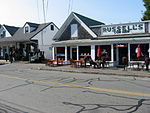Spaulding Rehabilitation Hospital Cape Cod
Buildings and structures in Sandwich, MassachusettsHospitals in Barnstable County, MassachusettsMassachusetts building and structure stubsNortheastern United States hospital stubs
The Spaulding Rehabilitation Hospital Cape Cod (SRHCC) is a rehabilitation hospital located in Sandwich, Massachusetts that serves both Cape Cod and the Islands. It was founded in 1995 and is part of the Spaulding Rehabilitation Network.It was previously known as the Rehabilitation Hospital of the Cape and Islands (RHCI), and still operates under that name. The hospital is owned by Partners HealthCare, a non-profit organization that owns several hospitals in Massachusetts.
Excerpt from the Wikipedia article Spaulding Rehabilitation Hospital Cape Cod (License: CC BY-SA 3.0, Authors).Spaulding Rehabilitation Hospital Cape Cod
Service Road,
Geographical coordinates (GPS) Address Phone number Website External links Nearby Places Show on map
Geographical coordinates (GPS)
| Latitude | Longitude |
|---|---|
| N 41.7329 ° | E -70.4681 ° |
Address
Spaulding Rehabilitation Hospital Cape Cod
Service Road 311
02537
Massachusetts, United States
Open on Google Maps








